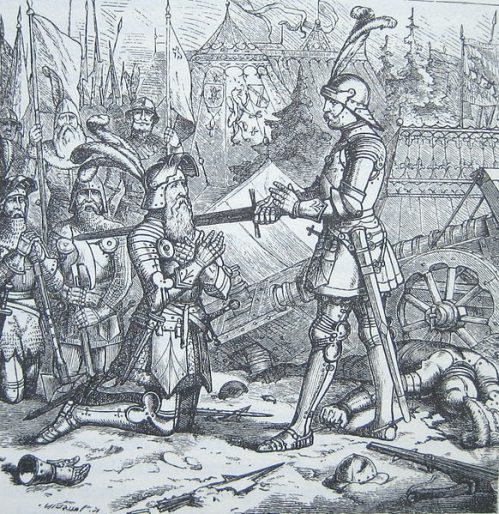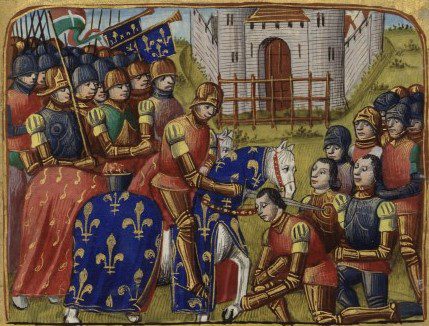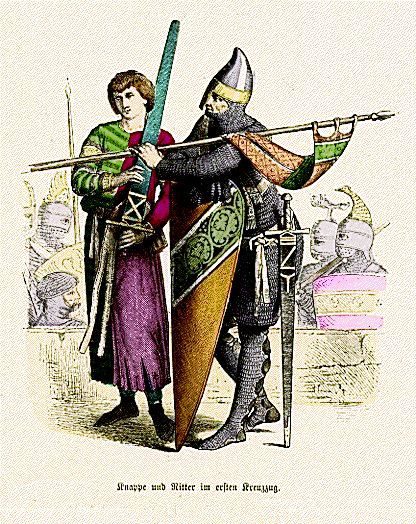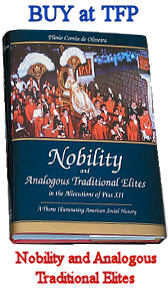At what age were the youths admitted to the eighth sacrament? There is no doubt that there existed some connection between the arrival at “majority,” and the period at which one could be dubbed knight. But the time when the youth attained his majority varied.
Amongst German tribes it varied. With the Salians it was twelve years, with the Ripuarians fifteen. These different dates obtained for a more or less lengthened period in the districts inhabited by the descendants of those tribes, and a curious vein of study is here opened to us. But of all the Germans it may bes aid as Theodoric said of the Goths, “It is strength that regulates the attainment of the majority. As soon as he was big enough to fight, the young barbarian came of age.”
However that may have been, thanks to the softening tone of manners and under the visible influence of Roman Law, there has arisen amongt us a more and more marked tendency to postpone the arrival at majority, and to fix the date of coming of age at twenty or twenty-one. This tendency had already obtained to a certain extent in the twelfth century. In Glanville, in the Très ancien Coutumier Normand, it is fixed at twenty-one. In the thirteenth century the custom became still more accentuated. It is true that in Beauvaisis the old German custom is adhered to, and fifteen is stated as the period of coming of age; but the Coutume de France mentions twenty, while the second part of Très ancien Coutumier Normand, the Très ancien Coutume d’Anjou, and the Etablissements de Saint Louis are unanimous in putting the period, thenceforth agreed upon, at twenty-one. In the twelfth century the unanimity was still more striking, and it is best to accept that age here. So twenty-one years was the tgime for coming of age—not twenty-one years accomplished, but only entered upon.
 Well, all these variations regarding the age of majority we find repeated when the question of the proper time for dubbing the aspirant a knight arose. So once again we find an evident parallelism between these two questions. But on the plain of Chivalry the German idea resisted longer, much longer, than the on the level of Majority.
Well, all these variations regarding the age of majority we find repeated when the question of the proper time for dubbing the aspirant a knight arose. So once again we find an evident parallelism between these two questions. But on the plain of Chivalry the German idea resisted longer, much longer, than the on the level of Majority.
In our chronicles as in our chansons de geste, which so accurately reflect the Chivalresque life of the period, we find many opinions regarding the age for becoming a knight; and these are not easy to reconcile. They prove to us that an aspirant might become a knight at twelve, thirteen, fourteen, fifteen, seventeen, and nineteen. If I had to give the average age I should say fifteen—the period of arriving at majority amongst the Germans!
But it is necesary to take into consideration the same influences which concurred in pushing back the age for the attainment of the majority, and we must state that the tendency became more and more marked to “push back” the age for the bestowal of knighthood to twenty-one also. But this was no easy matter.
 In the thirteenth century twenty-one was the fashionable age. If Arthur were dubbed knight at fifteen, it was for political reasons. If Philip the Fair was in after years knighted at sixteen, it was for similar reasons, for he was actually King of Navarre at the time. On the other hand, the sons of Saint Louis and of Philip the Fair were not armed until they were twenty years of age. “One cannot attain one’s majority, nor become a knight, until after one has entered on his twenty-first year.” Such is the present rule, and we can find very few exceptions to it in France; but we are now very far from German traditions, and even from the twelfth century.
In the thirteenth century twenty-one was the fashionable age. If Arthur were dubbed knight at fifteen, it was for political reasons. If Philip the Fair was in after years knighted at sixteen, it was for similar reasons, for he was actually King of Navarre at the time. On the other hand, the sons of Saint Louis and of Philip the Fair were not armed until they were twenty years of age. “One cannot attain one’s majority, nor become a knight, until after one has entered on his twenty-first year.” Such is the present rule, and we can find very few exceptions to it in France; but we are now very far from German traditions, and even from the twelfth century.
In brief, our damoiseau, the youth whom we have followed day by day, is yet only fifteen and will be dubbed knight. It is quite true; his feathers are overlapping the nest! Pennae nido majores. He cannot hide his exultation, and he goes about the castle singing, “A knight, a knight, I am to be dubbed a knight!”
León Gautier, Chivalry, trans. Henry Frith (London: George Routledge and Sons, Ltd., 1891), 210–2.







